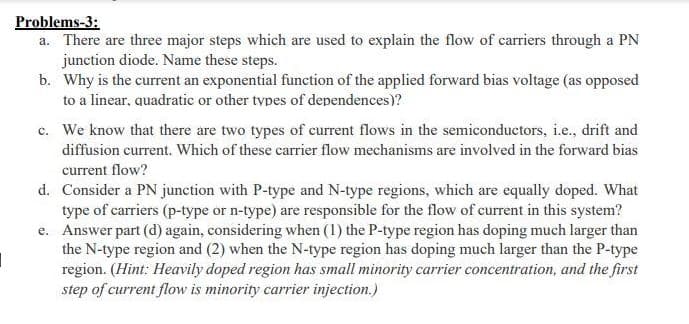a. There are three major steps which are used to explain the flow of carriers through a PN junction diode. Name these steps. b. Why is the current an exponential function of the applied forward bias voltage (as opposed to a linear, quadratic or other tvpes of dependences)? c. We know that there are two types of current flows in the semiconductors, i.e., drift and diffusion current. Which of these carrier flow mechanisms are involved in the forward bias current flow? d. Consider a PN junction with P-type and N-type regions, which are equally doped. What type of carriers (p-type or n-type) are responsible for the flow of current in this system? e. Answer part (d) again, considering when (1) the P-type region has doping mụch larger than
a. There are three major steps which are used to explain the flow of carriers through a PN junction diode. Name these steps. b. Why is the current an exponential function of the applied forward bias voltage (as opposed to a linear, quadratic or other tvpes of dependences)? c. We know that there are two types of current flows in the semiconductors, i.e., drift and diffusion current. Which of these carrier flow mechanisms are involved in the forward bias current flow? d. Consider a PN junction with P-type and N-type regions, which are equally doped. What type of carriers (p-type or n-type) are responsible for the flow of current in this system? e. Answer part (d) again, considering when (1) the P-type region has doping mụch larger than
Power System Analysis and Design (MindTap Course List)
6th Edition
ISBN:9781305632134
Author:J. Duncan Glover, Thomas Overbye, Mulukutla S. Sarma
Publisher:J. Duncan Glover, Thomas Overbye, Mulukutla S. Sarma
Chapter4: Transmission Line Parameters
Section: Chapter Questions
Problem 4.2P: The temperature dependence of resistance is also quantified by the relation R2=R1[ 1+(T2T1) ] where...
Related questions
Question
answer all

Transcribed Image Text:Problems-3:
a. There are three major steps which are used to explain the flow of carriers through a PN
junction diode. Name these steps.
b. Why is the current an exponential function of the applied forward bias voltage (as opposed
to a linear, quadratic or other types of dependences)?
c. We know that there are two types of current flows in the semiconductors, i.e., drift and
diffusion current. Which of these carrier flow mechanisms are involved in the forward bias
current flow?
d. Consider a PN junction with P-type and N-type regions, which are equally doped. What
type of carriers (p-type or n-type) are responsible for the flow of current in this system?
e. Answer part (d) again, considering when (1) the P-type region has doping much larger than
the N-type region and (2) when the N-type region has doping much larger than the P-type
region. (Hint: Heavily doped region has small minority carrier concentration, and the first
step of current flow is minority carrier injection.)
Expert Solution
This question has been solved!
Explore an expertly crafted, step-by-step solution for a thorough understanding of key concepts.
This is a popular solution!
Trending now
This is a popular solution!
Step by step
Solved in 2 steps with 1 images

Knowledge Booster
Learn more about
Need a deep-dive on the concept behind this application? Look no further. Learn more about this topic, electrical-engineering and related others by exploring similar questions and additional content below.Recommended textbooks for you

Power System Analysis and Design (MindTap Course …
Electrical Engineering
ISBN:
9781305632134
Author:
J. Duncan Glover, Thomas Overbye, Mulukutla S. Sarma
Publisher:
Cengage Learning


Power System Analysis and Design (MindTap Course …
Electrical Engineering
ISBN:
9781305632134
Author:
J. Duncan Glover, Thomas Overbye, Mulukutla S. Sarma
Publisher:
Cengage Learning
